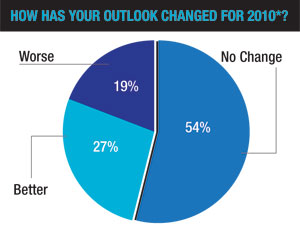While the federal stimulus program has helped many construction industry firms avoid the most immediate, far-reaching and detrimental impacts of the recession, it hardly has been a panacea for all or a substitute for tough strategic decisions. As markets shift, shrink or even disappear, some companies are scrambling to adjust, while others, having seen signs of tough times ahead, execute game plans adopted before the downturn hit.


Some industry observers believe this recession is more difficult than past slumps because so many firms have built up capacity over years of boom. Trying to maintain that size has led companies into bidding wars, risky price cutting and corporate pain. “If 2009 could be described as the year of scratch-and-claw, then 2010 will be the year of hand-to-hand combat,” says Gregory DiFrank, president of River Consulting LLC, Columbus, Ohio. But others say the market is resilient and will generate opportunity for firms that reach deep into their talent pools to find and create new paths ahead.
“Once survival is no longer an issue, thinking about how to take advantage of future growth markets is critical,” says Hugh L. Rice, principal of FMI, the Denver construction management consultant and investment banker. “The market will recover, but it will be at different rates and at different times for different sectors. Firms need to think strategically about what forces will create a demand for construction and position appropriately.”
Market challenges now compel firms to tap, for themselves, the same creative juices flowing to clients. “Waiting for the market to come back without significant strategies to adapt could result in slow, painful death,” says John Cryer, principal of Houston architect-engineer PageSoutherlandPage. Adds Paul Yarossi, president of HNTB, “resisting the temptation to hunker down is essential.”
Scott Kolbrenner, managing director of management firm Houlihan Lokey, Los Angeles, and co-head of its infrastructure services and materials group, advises firms to “pay down debt, raise equity if necessary, focus on operations and cash flows but keep planning for the intermediate future, maintain morale in qualitative ways with employees and consider long-term value enhancements, not short-term Band-Aids.”
Paul Steelman, Steelman Partners, Las Vegas, sees the new reality. “Many architects are rushing to take the word ‘iconic’ off their Web pages,” he says. The firm is diversifying its geography and markets but must self-fund the effort amid its own credit crunch, he says.
For many firms, the federal stimulus has made a difference. Sylvia Medina, president of North Wind Inc., an Idaho Falls engineer, says U.S. Energy Dept. stimulus work contributed to a revenue boost last year and will do so again in 2010. One contract worth $14 million pre-stimulus has grown to $60 million and created 60 new jobs. But the stimulus did little to boost markets for POWER Engineers, Hailey, Idaho, says President Jack Hand. “Our generation business has been hit the hardest,” he says, adding that any improvement in 2010 will come from its work in the geothermal market.
Others also see little benefit from the stimulus, which “is like adding a little fresh, hot coffee to a half-full cold cup,” says Craig Martin, CEO of Jacobs Engineering Group Inc. “It doesn’t make it hot or fill it up.” The Pasadena, Calif., engineering giant will cling tight to its clients and to cost control, while taking advantage of market conditions to grow the firm’s share in industrial and infrastructure, particularly overseas. Acquisitions will continue as a key strategy.
Martin cautions that firms must be especially prudent now in judging the risk levels they are willing to take on. “We expect to see casualties from this approach over the next 12 to 24 months,” he says.
With weak capital markets fueling fewer megaprojects, particularly in the U.S., Black & Veatch “is expanding into the services area, and we are having success,” says Rodger Smith, president of the Kansas City-based engineering...





Post a comment to this article
Report Abusive Comment